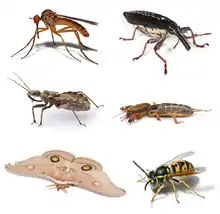Eumetabola
Eumetabola is an unranked clade of Neoptera. Two large unities known as the Paurometabola and Eumetabola are probably from the adelphotaxa of the Neoptera after exclusion of the Plecoptera. The monophyly of these unities appears to be weakly justified.[1]
| Eumetabola | |
|---|---|
_on_Tribulus_terrestris_W_IMG_1020.jpg.webp) | |
| Apis dorsata on Tribulus terrestris | |
| Scientific classification | |
| Kingdom: | Animalia |
| Phylum: | Arthropoda |
| Class: | Insecta |
| Infraclass: | Neoptera |
| (unranked): | Eumetabola |
Eumetabola has the highest number of species of any clade. According to recent molecular phylogenetic analyses Eumetabola could have first appeared in Middle Devonian (391 million years ago) to the era of late Pennsylvania (311 million years ago). In addition to this, it would have also appeared in Hemiptera (310 million years ago).
Phylogeny
The phylogeny of Eumetabola is shown in the cladogram according to Kluge 2004, 2010, and 2012:[2][3][4]
| Neoptera |
| ||||||||||||||||||||||||||||||||||||||||||||||||||||||||||||||||||||||||||||||||||||||||||||||||||||||||||||
| Wikispecies has information related to Eumetabola. |
References
- Paurometabola — Eumetabola link.springer.com
- Kluge, Nikita J. (2004). "Larval/pupal leg transformation and a new diagnosis for the taxon Metabola Burmeister, 1832 = Oligoneoptera Martynov, 1923" (PDF). Russian Entomological Journal. 13 (4): 189–229.
- Kluge, Nikita J. (2010). "Circumscriptional names of higher taxa in Hexapoda" (PDF). Bionomina. 1: 15–55.
- Kluge, Nikita J. (2012). "General System of Neoptera with Description of a New Species of Embioptera" (PDF). Russian Entomological Journal. 21 (4): 371–384.
External links
- Eumetabola Hennig 1953 insecta.bio.spbu.ru
- Grimaldi, D.; Engel, M. S. 2005: Evolution of the insects. Cambridge University Press, New York. limited preview on Google books
- “The Earliest known Holometabolous insects”

